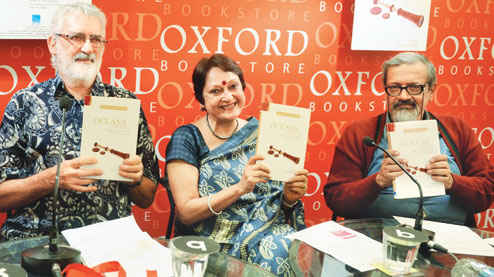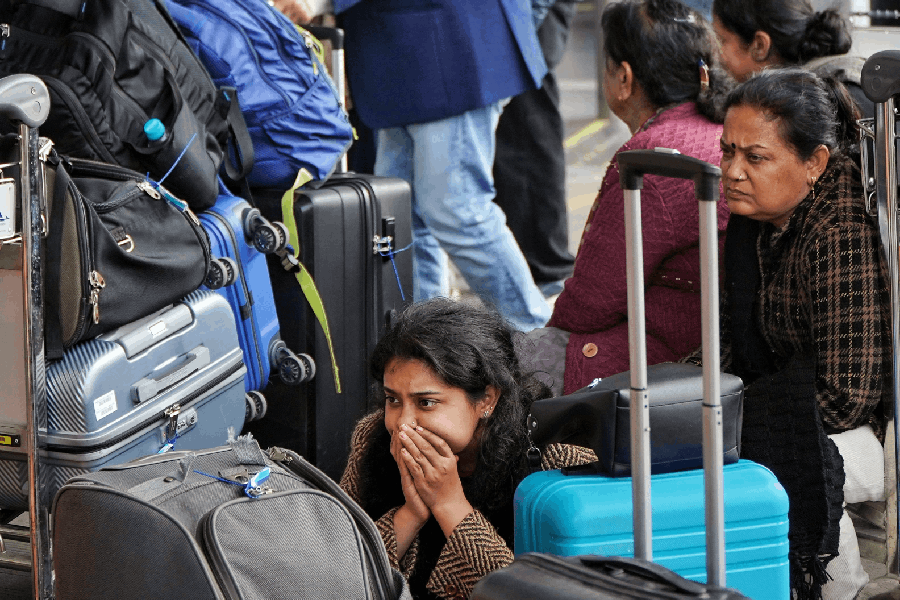 |
| (From left) Michael Pearson, Rila Mukherjee and Hari Vasudevan at Oxford Bookstore. (Pradip Sanyal) |
Oceans are not blank spaces on the map, nor are they gaps in the histories of a world consisting of continents. This observation penned by a maritime historian delineates the premise on which the study of oceans stands. Maritime and trade history studies, which was a living area in the mid 20th century, is now back in focus. The area was enriched by the release of Oceans Connect: Reflections on Water Worlds across Time and Space at Oxford Bookstore recently. The book, edited by Rila Mukherjee, explores how people, goods and ideas travelled across waters making the history of the oceans become a vehicle for understanding global history.
“Rila has cast her net far and wide,” said Michael Pearson, professor emeritus at New South Wales University, who launched the book which has contributors from five countries spread across the globe. The expert on Indian Ocean history referred to a pioneering start to the area in 1940s and the vast historiography now available on the Pacific and Atlantic oceans as well as the Mediterranean and the South China seas. “Historians like us are comfortable with the idea of time. The book has made an important contribution to a discussion on space.”
Hari Vasudevan, the former director of Maulana Abul Kalam Azad Institute of Asian Studies, who had in that capacity sponsored a seminar on maritime studies of which this book is the outcome, provided a background. “People in Europe are fascinated by stories of the Dutch and the Portuguese as sea-borne empires. How the British came to control India became an imperial story. This made scholars like Asin Dasgupta worry about how Indian traders were represented in history. Then some experts pointed to the presence of Arabian vessels on the Indian Ocean. Thus a supposedly single sequence of events began to disintegrate and questions also started being asked whether the Portuguese who came sailing were new Christians, renegades or conspirators against the empire. It was not a nationalist story any more,” he said.
 |
| (Right) Jeffrey K Reneau releases Steve Raymer’s book. Picture by Anindya Shankar Ray |
He added how accounts of each ocean became part of a large space that ran from ocean to ocean. “What happened in Indian Ocean passed to Pacific and came down to the Atlantic. The edges began to blur. The result was technical advancement in nautical science, emergence of maps and the mingling of communities globally,” he said, citing Mukherjee’s essay in the book on how images of marine gods were passed around globally.
Mukherjee, the director of the Institut de Chandernagor, said: “This book is a prelude to a panel proposal we will submit to the International Water History Association at Montpellier in June 2013.”
Also present at the launch was Radhika Seshan, associate professor of the department of history at University of Pune, who is co-editing a series called Issues in History of which this book is the first volume.
Calcutta clicks
American photojournalist Steve Raymer recently logged on to Skype and had an hour-long chat with his fans and photographers in Calcutta. The occasion: the launch of Raymer’s latest book Redeeming Calcutta: A Portrait of India’s Imperial Capital (OUP, Rs 3,650). The event at the American Center library was organised by the American Center and Oxford University Press.
The book, with around 200 photographs, takes a fresh look at Calcutta, capturing it in its various moods. It also has an essay on Calcutta’s history by Raymer, who teaches visual journalism and other subjects at Indiana University. The essay is accompanied by black and white photographs from the Library of Congress and the British Empire and Commonwealth Museum.
“Society is increasingly going digital, so when we had the opportunity to conference with a world-class photographer on a book about the city, we grabbed the opportunity,” smiled the American Center director, Jeffrey K. Reneau, as he released the book with Prabal Biswas of OUP, in the author’s digital presence.
(Contributions by Sudeshna Banerjee and Sreyoshi Dey)











